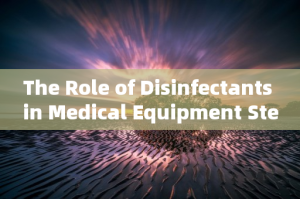In the field of healthcare, ensuring the sterility of medical equipment is paramount to safeguard patient health and prevent the spread of infections. One crucial aspect of achieving this goal is the use of disinfectants, which play a pivotal role in the sterilization process.
Below we will introduce the classification and functions of different disinfectants
Isopropanol (Isopropyl Alcohol)
Isopropanol, commonly known as isopropyl alcohol, is a versatile disinfectant widely used in medical facilities. It is known for its effectiveness in killing a broad spectrum of microorganisms, including bacteria, viruses, and fungi. Isopropanol is often used for surface disinfection and for preparing the skin before medical procedures.
Key functions of Isopropanol in medical equipment sterilization include:
Surface Disinfection: Isopropanol is applied to surfaces, equipment, and instruments to eliminate microbial contaminants.
Skin Preparation: It is used to disinfect the skin before injections, venipuncture, and surgical procedures, reducing the risk of infections.
Evaporative Properties: Isopropanol evaporates quickly, leaving no residue behind, which is advantageous in a sterile environment.
Hydrogen Peroxide (H2O2)
Hydrogen Peroxide is another essential disinfectant utilized in healthcare settings. It is a powerful oxidizing agent that can destroy a wide range of microorganisms, making it a valuable tool in the fight against infections.

Key functions of Hydrogen Peroxide in medical equipment sterilization include:
High-Level Disinfection: It can be used for high-level disinfection of medical devices and instruments.
Spore Elimination: Hydrogen Peroxide is effective against bacterial spores, making it suitable for critical equipment sterilization.
Environmentally Friendly: Unlike some other disinfectants, Hydrogen Peroxide breaks down into water and oxygen, making it environmentally friendly.
Alcohol-Based Solutions
Alcohol-based disinfectants, such as Ethanol (Ethyl Alcohol) and Isopropanol, are commonly used in healthcare settings for their rapid action against microorganisms. They are often found in hand sanitizers, surface disinfectants, and as components of more complex cleaning solutions.
Key functions of Alcohol-Based Solutions in medical equipment sterilization include:
Quick Action: They provide rapid disinfection, making them ideal for busy healthcare environments.
Skin-Friendly: Alcohol-based hand sanitizers are gentle on the skin and widely used for hand hygiene.
Surface Disinfection: These solutions are effective for disinfecting surfaces and equipment.
Conclusion
In the world of healthcare, the importance of proper disinfection and sterilization of medical equipment cannot be overstated. Various disinfectants, including Isopropanol, Hydrogen Peroxide, and Alcohol-based solutions, play pivotal roles in this process. They help eliminate microbial contaminants, reduce the risk of infections, and maintain a sterile environment.
Healthcare professionals must select the appropriate disinfectant based on the specific requirements of the equipment or surface being treated. Furthermore, adherence to strict disinfection protocols is crucial to ensure patient safety and the prevention of healthcare-associated infections.